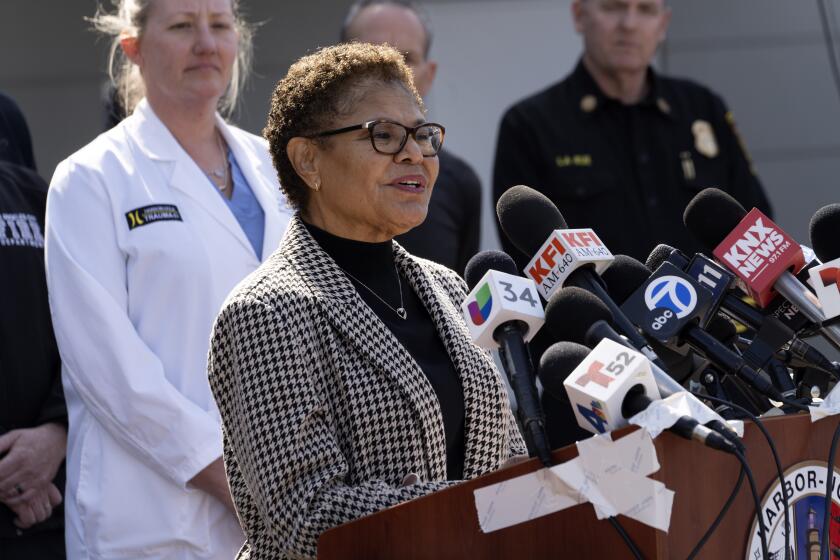Bradley’s Sewer Woes Have Statewide Outfall
Nobody ever figured Los Angeles Mayor Tom Bradley as the slow-growthers’ friend, and it’s not likely that, at age 70, he’s changed his philosophy. That’s what makes themayor’s recent proposal to limit sewer hookups throughout the Los Angeles area all the more important as a lesson to California’s political leadership.
Under considerable pressure from slow-growth advocates to deal with an overloaded sewer system, Bradley has called for a limited allocation of new sewer hookups over the next three years--not just for buildings in Los Angeles, but for projects in the 30 or so cities and special districts around Southern California that use the Los Angeles system. He even called for building moratoriums in three cities--Santa Monica, Burbank and San Fernando--that he has no political control over, but which pump more sewage into the Los Angeles system than their contracts call for.
For years, Bradley has resisted limits on development, often making ringing declarations against growth control. But on the sewage issue, he had to call for growth limits--indeed, regional growth limits--because an urgent health issue forced him to. It was a vivid example of the political power the growth-control movement can wield when it is able to use health and environmental issues to attack growth on a regional level. And it is a signal the state’s traditionally pro-growth political leadership in Sacramento can’t afford to ignore.
Until now the California growth-control push has been powerful in certain areas, but it hasn’t gathered broad enough support to become a full-fledged political movement. That’s because the slow-growthers’ political clout has always been regarded, particularly in Sacramento, as “just local.” Anti-growth sentiment may rage in Santa Monica and San Franciscoor even Los Angeles and San Diego--but that rage isn’t easily transportable across municipal boundaries, and for this reason it rarely affects the outcome of legislative races.
The reason growth control has heretofore remained local is that, in many cases, slow-growthers are simply protecting their own interests, not expressing support for some larger political principle. It’s hard to get worked up about a skyscraper being built in somebody else’s neighborhood when you’ve already made sure nobody can put one up near you.
That’s why Southern California has continued to grow at such a remarkable rate even in the face of intense anti-growth pressure. Local growth-control measures don’t really stop development; usually they just move it around--from Santa Monica to Los Angeles, from Los Angeles to Valencia, from Orange County to Riverside County. The real growth decisions are made on the regional and state level: the decisions of water supply agencies, the allocation of sewer capacity (much of which happens to be controlled by the city of Los Angeles), the intensity (or laxity) of the fight against smog and, especially, the state Legislature’s willingness to commit both financial resources and political support to more growth.
In those arenas, business and construction lobbies have always stoked California growth with great skill. And as long as they do, it won’t much matter how many cities pass growth-control ordinances.
But concerns about public health (and, to a lesser extent, about the environment) can change that equation. Southern Californians may not care whether someone else has to live in the shadow of a skyscraper, but they do care about the air they breath, the water they drink and the ocean they swim in or sail on. These concerns can be translated into a much more powerful and transportable political movement, capable of attacking the regional growth machine at its source.
Bradley’s three-year limit on sewer hookups, which came about largely because of pressure from the growth-control crowd, is a leading example of the political clout slow-growth proponents can acquire from health issues. For years, Los Angeles and neighboring cities had virtually ignored the fact that they were hurtling toward a regional sewage crisis. Even Santa Monica, having imposed strict slow-growth policies in the last decade, was dumping more sewage into the Los Angeles system than its contract called for, a situation accepted as a fact of life by both cities.
In the past year, however, overflows into Santa Monica Bay provided slow-growthers with a high-profile issue that helped give them mainstream, regionwide political legitimacy they couldn’t have obtained any other way. Limiting the heights of buildings in Hermosa Beach or the number of new houses in Thousand Oaks--or even passing Proposition U, the 1986 Los Angeles growth-limit initiative--may be an impressive political achievement, but it’s “just local.” Using the mayor of Los Angeles as a lever to shut off development in Santa Monica and Burbank, on the other hand, is a stunning coup that the state’s political leadership had better pay attention to.
Sewage will not be the only issue that lends itself to this kind of regional anti-growth attack. Recent state legislation gives the South Coast Air Quality Management District far more control over pollution-inducing growth throughout greater Los Angeles. Regional trash disposal and transportation problems are constantly in the headlines. As the Los Angeles sewage experience suggests, all these issues will give the slow-growth advocates more political power, meaning they will be able to step into the larger arena and demand significant restrictions regionwide.
Like Bradley in Los Angeles, some political leaders in Sacramento have begun to recognize that growth control could become be a statewide political issue. They see that while the growth-control movement hasn’t shut down development in California, it is breaking up the growth consensus that the state has thrived on since the days of Gov. Edmund G. (Pat) Brown. But, unlike Bradley (who must handle slow-growthers deftly in order to win reelection), Sacramento leaders haven’t learned that the health issue gives slow-growthers legitimate, mainstream political power.
The rules of the game have changed. Growth may indeed be good but, as Bradley has discovered, threats to public health and natural resources are powerful and legitimate issues that must be dealt with, not suppressed. Manifest-destiny-style declarations about California’s future may play well in Sacramento, but they sometimes sound pretty hollow back home when the air stinks and raw sewage is flowing into the Pacific Ocean.
Gov. George Deukmejian, Assembly Speaker Willie Brown and the rest of the Sacramento leadership must take dramatic steps quickly toward a new consensus on growth--one recognizing not just the need for economic (and population) expansion, but also the need to deal with the health and environmental consequences of growth. Otherwise, this state may be dragged into an unwinnable fight between those who want growth without responsibility and those who want responsibility without growth.
More to Read
Start your day right
Sign up for Essential California for news, features and recommendations from the L.A. Times and beyond in your inbox six days a week.
You may occasionally receive promotional content from the Los Angeles Times.






